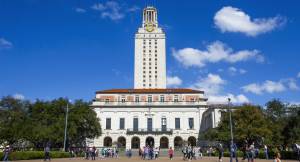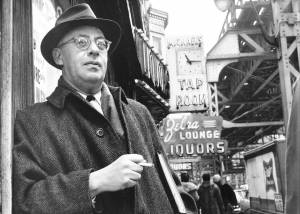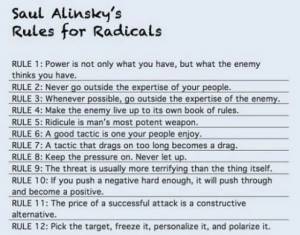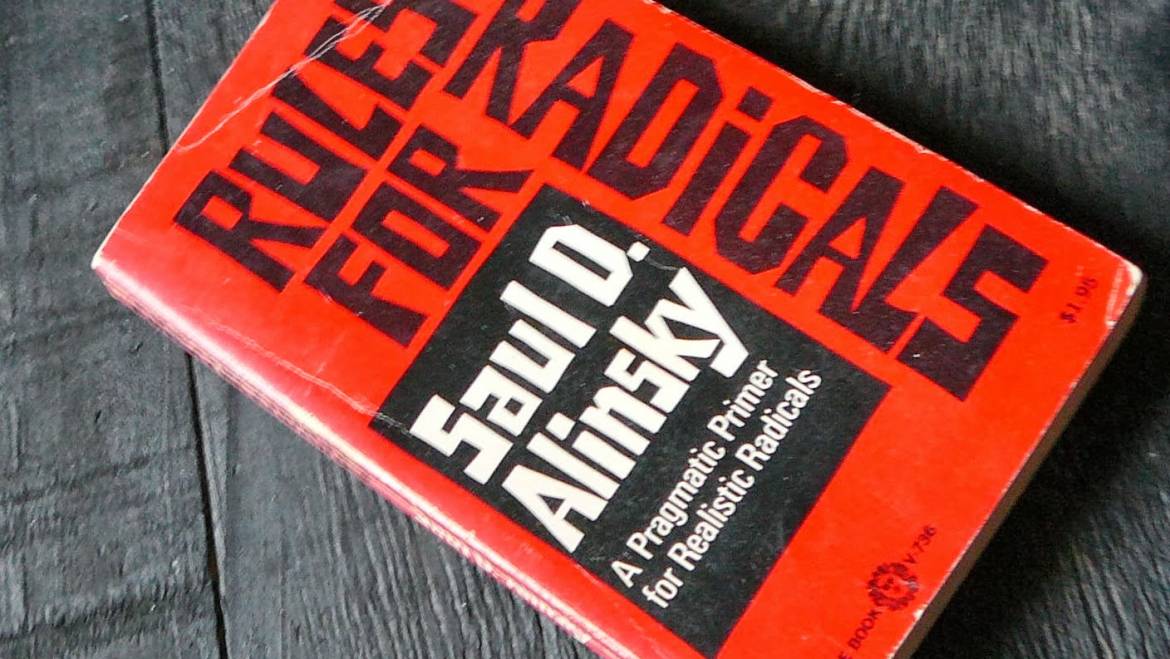Many people look back on their college days with unalloyed happiness. I had a bit of that during my four years at the University of Texas, but I can also remember worry, pressure and feelings of insecurity. It was a big campus packed with 40,000 students. While some were on a fast track to academic, personal and financial success, others dropped out or even committed suicide as they took a flying leap from the observation deck of the 27-story Tower. I was in between those extremes, just trying to get by.
Among my least favorite UT memories is sitting in large auditoriums with 200, 300 or even 400 others. In utter anonymity, we pretended to listen to a professor on a stage who was talking in a monotone. Assembly-line higher education at its worst, it upset me greatly. I derived even more cognitive dissonance from some of the books we had to read in order to pass tests and move toward graduation. None was more irksome than Rules for Radicals / A Practical Primer for Realistic Radicals (1971) by Saul Alinsky. The course, I believe, was Government 312L, “Introduction to Political Behavior.” I cannot remember who taught it, but classes were held in either the auditorium of Burdine Hall or what was then called the Business Education Building.
Before going any further, I will point out that the title is flawed; “practical” and “realistic” are synonymous, and “radicals” appears twice. Whether this decision was made by Random House or Alinsky, it was a poor one in my view.
Saul Alinsky was born in 1909 in Chicago to Russian-Jewish immigrant parents, earned a degree in archeology from the University of Chicago and was soon working as a community organizer in South Side slums, not to mention those in Kansas City, Detroit and Oakland. Illinois Governor Adlai Stevenson thought highly of him, saying that Alinsky’s goals “most faithfully reflect our ideals of brotherhood,  tolerance, charity and dignity of the individual.” He had many other admirers, most of all the 1960s leftists he trained and encouraged. His critics called him (among other things) “the American Machiavelli.” He denied being a follower of Karl Marx, but his writings seem to show that he was. I think anybody who speaks of “the bourgeois class structure” qualifies as a Marxist. He advised splinter groups to identify an enemy—a person or branch of the government—and then find ways to create conflict.
tolerance, charity and dignity of the individual.” He had many other admirers, most of all the 1960s leftists he trained and encouraged. His critics called him (among other things) “the American Machiavelli.” He denied being a follower of Karl Marx, but his writings seem to show that he was. I think anybody who speaks of “the bourgeois class structure” qualifies as a Marxist. He advised splinter groups to identify an enemy—a person or branch of the government—and then find ways to create conflict.
Hilary Clinton wrote her senior thesis at Wellesley College about him (letters between Clinton and Alinsky can be found in a UT library), and Bernie Sanders, William Ayers, Bernadine Dohrn, Barack Obama and others have claimed to be his spiritual descendants. Obama got his start as a community organizer in Chicago, and during his eight-year administration he quoted or paraphrased Alinsky many times.
In fact, this book was a recycling of his 1946 Reveille for Radicals. In it (the 1971 version), Alinsky made a rather unusual dedication: “to the first radical known to man who rebelled against the establishment and did it so effectively that he at least won his own kingdom—Lucifer.” I do not intend to go over what Alinsky said and advocated in his book other than to say it was about left-wing political agitation and social reform, if not revolution. I have no problem with Alinsky’s writing such a book or Random House publishing it, but I draw a line at it being listed as required reading at a public university.
Who makes decisions about required reading for undergraduates—faculty members? Deans? Administrators? Seriously, where in academia are these decisions made? I also wonder whether UT (a school known then for its unusually high student-to-faculty ratio) had a system in place to ensure that only suitable books were required reading. I would hope that the university had set some well-considered criteria for the matter.
Since I wanted to pass that course, I went to the University Co-op on the Drag and bought Alinsky’s tome along with other required-reading books. I plodded through it, learning little but realizing that this far-left-wing stuff was being crammed down my throat. Quiet as a lamb, I went along although I was not a radical and had no desire to be one. I regret never sounding out any of my fellow students. What did they think about having to read Rules for Radicals?
Just 19 years old at the time, I was muddling my way to a diploma and lacked the awareness, and emotional and intellectual foundation needed to contest it. I should have taken Alinsky’s advice to heart and done some fairly “radical” things. He called for direct action, did he not?
- I might have gone to the professor during his office hours and protested the inclusion of this book on the required reading list.
- If unsatisfied with his response, I might have stood up in class and ridiculed him (one of Alinsky’s favorite tactics).
- I might have started a petition along with other displeased students.

- I might have led a group of students who interrupted the professor’s lectures with the following chant: “Hey hey, ho ho, Rules for Radicals has got to go!”
- I might have written to the dean of the UT College of Liberal Arts and remonstrated, followed by a letter to President Stephen Spurr.
- I might have written a guest editorial in the Daily Texan about this matter, asking why no book on the right end of the political spectrum was required reading—perhaps one that celebrated the USA as the greatest country in the history of the world.
Hey, I am all in favor of grass-roots participatory democracy. And as indicated earlier, I do not gainsay Alinsky’s writing this book. But it had no place on the required reading list at UT (or any other public school) in 1972 (or ever). Alinsky has since been refuted by David Horowitz in Barack Obama’s Rules for Revolution / The Alinsky Model (2009), Michael Patrick Leahy in Rules for Conservative Radicals / Lessons from Saul Alinsky, the Tea Party Movement and the Apostle Paul in the Age of Collaborative Technologies (2009), Michael Walsh in Rules for Radical Conservatives / Beating the Left at Its Own Game to Take Back America (2010), Michael Master in Rules for Conservatives / A Response to Rules for Radicals by Saul Alinsky (2012) and Jeff Hedgepeth in Rules for Radicals Defeated / A Practical Guide for Defeating Obama/Alinsky Tactics (2012).


12 Comments
Richard:
I agree with you 100% about “why?” such political trash. Why brainwash this generation with Marxism? Why UT of all schools?
It is subversive and where is Joseph McCarthy when we needed him?
I knew Hillary, Obama and Bill Ayers worshiped him and used his trash philosophy in their political careers to destroy America.
I don’t think the subversive movement is over, not with Bernie Sanders’ heart still beating.
Wackos…. all of them. There is so many more out there, ruling in the Congress and in our seats of state and local government, even in our federal and state judge seats.
The books you recommended that counter-punch Alinsky’s lie’s and anti-American zeal are now on my read list.
Thanks
Mr. Scoggins: You are right about Bernie Sanders, just starting up another campaign. Heaven help us…. Although I hold Trump in low regard, I would vote for him rather than Sanders.
As much as I love the Longhorns, in retrospect such required reading at UT does not surprise me one bit. In fact, it fits right in with the mindset of Austin liberalism.
I never saw this type of education coming at the time when I was 19 years old. My brother went to Texas before me and loved it. I think he fell more in love with the freedom of being away from home and being on his own more than anything else. He bled Orange.
As for me, I went along with it at the time, bought in to what was being fed, er, taught us (like Mr. Alinsky readings) because that was the thing to do. I was just getting an education. I’ve changed over the years from life’s experiences. I don’t regret graduating from Texas, it was a great experience, but you really have to keep your eyes open, as well as your mind. At the time I learned a lot. Today, I’ve changed my mind on much of it. It’s just not me.
You and me, Steve, we just “went along with it.”
Richard- Wow-required reading at UT in the early ’70’s! I guess the Left had already made major steps in co-opting our universities even then. They have since completed the job and brainwashed a generation instead of educating them. Very sad. Rules for Radicals was definitely not on the reading list at my school, as you could guess!
Kevin, this was blatant left-wing political indoctrination. It angered and alienated me then and still does. As you say, what’s it like today? I think I would need to find a “safe place” on the 40 Acres, hahahaha!!!
All you have to do is look at his followers and see what their ideology is. Evil comes from this type of thought, especially when you dedicate something to Lucifer! Take care, great article. BTW, banning Koreans from golf? How about banning Kenyans from running!
An excellent point, Kenny….
Great article. Thank you for writing it and doing an excellent job to present your point of view. You are 100% spot on.
Thanks, Eric.
SA spoke at old Mac in the spring of 1969. I remember being quite irritated (those WERE irritating times) by his hateful but glib messages. Here I was, a kid from the wrong side of the tracks – and the river – in Joliet, Illinois. My undereducated parents had sacrificed to help me become the first college student/grad in both sides of the family’s history in America and this guy was telling me I was the problem. Huh? I certainly didn’t ‘go along’ with his baloney but didn’t open myself to his ridicule by challenging him with any questions. Two years later, I had a leftist philosophy prof who compared biblical prophets with the Black Panthers. This time I did open myself up, murmuring “That’s bullshit” as I walked out of the class. In four glorious years in Jacksonville, I received but two grades below ‘B’ and you can guess how I was saddled with half of them.
What was the other one, Dex?
I truly wish I would have protested in some form. At the very least, visit tie professor during office hours and state my views…ask him to justify his choice of required reading, etc.
Add Comment